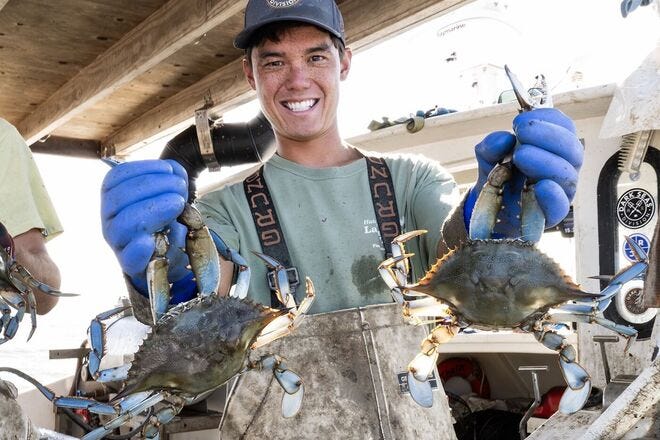TikTok’s most famous crabber explains why Maryland blue crabs are best
Luke McFadden shares his passion for Maryland blue crabs — Photo courtesy of Jay Fleming
Maryland waterman Luke McFadden never set out to be a TikTok star. As a commercial fisherman and crabber, he began his social media account as a way to sell his catch directly to customers.
“I never would have thought that so many would be interested in my content,” McFadden says. “To me, it’s just a day-to-day job.”
His TikTok account, @fvsoutherngirl (named after his fishing boat), has amassed almost 2 million followers by posting videos of his life as a crabber on the Chesapeake Bay. His viral content features step-by-step instructions, like the proper way to bait a crab trap or how to steam crabs. His account also livestreams his daily life, from waking up at 4 a.m. to load bait to harvesting more than 500 crab traps per day.
“It’s a very physically demanding job,” he says. “But I think that’s part of the appeal. A lot of people can relate to hard work, and I try to be transparent by showing the good, the bad, and the ugly.”
Shining a light on the Chesapeake Bay crabbing industry

There was a time when tens of thousands of watermen — a regional term for crabbers, oystermen, and fishermen — worked the waters of the Chesapeake Bay. Today, the National Oceanic and Atmospheric Administration estimates there are only a few thousand, and 28-year-old McFadden, who’s decades younger than many of his peers, is an outlier among them.
“There’s an aspect of the Chesapeake Bay that is a true wilderness, and that’s what I love about it,” he says, having spent more than 10 years on the water.

That love also drives his conservation-minded TikTok videos, as he documents beach cleanups and invasive species in the region. It’s a passion he shares with award-winning photographer Jay Fleming, who published a book documenting the lives of Chesapeake Bay watermen.
Food Culture: Lifelong resident says these are the best crab restaurants in Maryland
“Luke’s social media is drawing awareness to an industry that may not be around forever,” Fleming says. “The community of watermen and the fisheries are an important part of history.”
 It’s all in a day’s work on the Chesapeake Bay — Photo courtesy of Jay Fleming
It’s all in a day’s work on the Chesapeake Bay — Photo courtesy of Jay Fleming
When he’s not working 12-hour days on his boat, McFadden is selling his crabs at his crab stand, Bodkin Point Seafood. He also ships his crabs nationwide. Even after crabbing all day, McFadden still finds time to enjoy the occasional crab feast. We asked him what makes Maryland blue crabs so special, what goes best with a steamed crab feast, and even how to cook blue crabs.
 Steamed blue crabs are a Maryland summer tradition — Photo courtesy of Jay Fleming
Steamed blue crabs are a Maryland summer tradition — Photo courtesy of Jay Fleming
Why do you think Maryland crabs taste so good?
LF: One of the unique things about the Chesapeake Bay that you don’t get with the Gulf [of Mexico] or the Carolinas is the mix of fresh and brackish water. The upper Chesapeake Bay is mostly freshwater, and it gives them a different flavor. Maryland blue crabs also have a different life cycle than others. They hibernate in the winter, building up a fat reserve, which gives them a coat of thick yellow mustard, and a distinct flavor.
What is the best way to eat a Maryland crab?
LF: In Maryland, because you have the unique flavor profile, the best way to taste the actual crab is by steaming them. You are paying a premium for that great taste, and so you want to be able to taste the fatty meat, and the delicate, mustardy flavor.
Is it hard to steam crabs at home?
LF: Steaming crabs should not be an ordeal; anyone can do it. Some people think you need a lot of fancy equipment or a reason for celebration, but when I eat crabs, it’s usually just my wife and I cooking them on the stovetop. You can use a big soup pot with a collapsible metal steamer, or if you have a seafood steamer, even better.
What do you serve with steamed crabs?
LF: My favorite thing to eat is steamed corn or quartered potatoes and onions, because you can throw them into the same pot to steam with the crabs. I like to eat my crabs with melted butter and apple cider vinegar for dipping. But really, the best things to eat with steamed crabs is more crabs.
Luke McFadden’s Perfect Steamed Crabs
 Don’t forget to season your blue crabs — Photo courtesy of Jay Fleming
Don’t forget to season your blue crabs — Photo courtesy of Jay Fleming
- Take a large pot or seafood steamer and fill the bottom with equal parts white vinegar, water, and light beer or lager. The liquid should just reach the base of the container that will hold the crabs, but the crabs should not be submerged in liquid.
- Carefully place the crabs into the steamer, layering them to fit. A helpful tip is to cover your crabs with ice several minutes before steaming. This will slow down the crab — you don’t want to be chasing them around the kitchen!
- Once the crabs are in the steamer, douse them with some more beer. This will ensure that the seasoning sticks to the crab.
- Generously shake your favorite seafood seasoning, either Old Bay, or Luke’s signature blend, over the crabs.
- Put the lid on and turn the burner on high. Check the crabs after 20 minutes. Steamed crabs are ready when they are a bright orange or dark red all the way through, with no blue or green left on the top shell. The shell should pry open easily with a knife.
- Lay newspaper on your table, grab a mallet and a paring knife, and enjoy!




